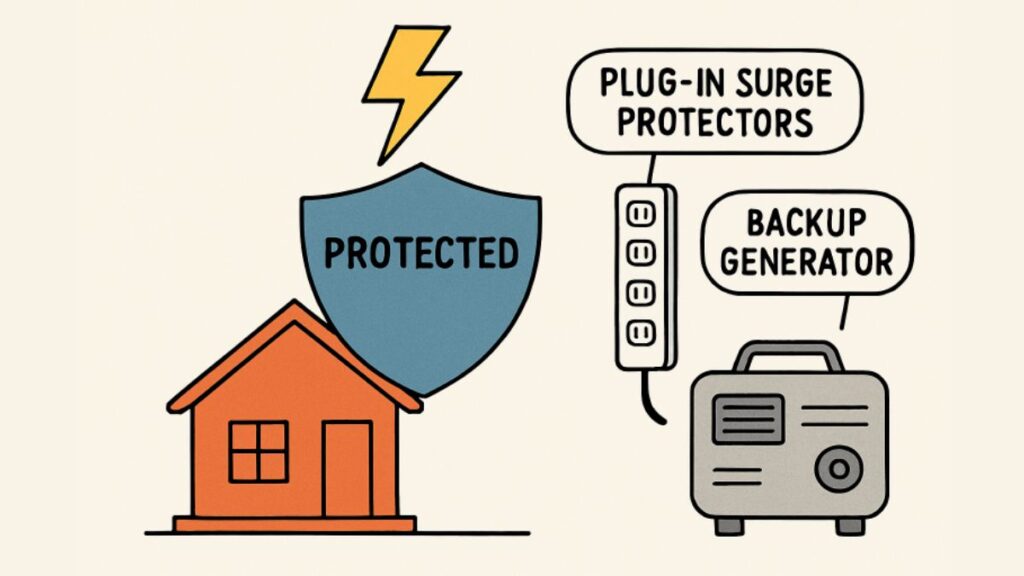Understanding Power Surges and Their Impact
Power surges are short, sharp spikes in electrical voltage that can inflict severe damage on sensitive electronics and major appliances. While these surges are commonly linked to external sources, such as lightning, it’s actually estimated that as much as 60-80% of surges originate inside the home itself. Large appliances switching on, faulty wiring, or tripped circuit breakers can all contribute to these hidden hazards. For homeowners, repeated exposure to even minor surges can steadily degrade the internal components of TVs, computers, or kitchen appliances, eventually leading to expensive repairs or the total loss of devices. Protecting your investment requires understanding both the risks and the solutions available. To ensure a safer, more prepared home, consult an experienced electrician in Indianapolis, Indiana who can recommend and install appropriate safeguards for your electrical system.
Damage from surges often goes unnoticed until it is too late. Electronic circuits are designed to handle a specific, stable voltage, so unpredictable jumps in electrical flow can fry delicate chips and render once-reliable devices useless. Major appliances likewise suffer from ongoing degradation of their motors and control boards if not adequately protected. With more smart home devices and higher-end appliances now found in nearly every household, defending against power surges has never been more critical. Routine assessments of your electrical panel and surge protection strategy ensure your home remains up to today’s safety standards.
In addition to surge risk, power outages themselves pose unique dangers, from spoiled food and inoperative medical equipment to personal safety concerns after dark. Comprehensively addressing home power security means approaching surge protection and backup power as complementary pillars of resilience.
Essential Devices for Surge Protection
Surge Protectors
Plug-in surge protectors, widely available for home use, work by redirecting or absorbing excess line voltage to prevent it from passing through to your electronics. When choosing a surge protector, prioritize models with a high joule rating and consider those offering data line protection for network-connected devices. It’s especially wise to provide dedicated protection for your entertainment systems, home office equipment, and kitchen appliances.
Uninterruptible Power Supplies (UPS)
Unlike surge protectors, a UPS offers both voltage protection and temporary backup power. During an outage, a UPS can provide minutes (or longer, depending on size) to save essential work, safely shut down computers, or continue running alarm systems until power is restored. Modern UPS devices often include surge suppression and are particularly useful for work-from-home setups or protecting crucial data.
Whole-House Surge Protectors
A whole-house surge protector installs directly into your home’s main service panel, shielding every circuit from sudden voltage increases—especially valuable during major outages or after a lightning strike in the area. An experienced electrician Indianapolis, IN can ensure the installation is done safely and meets all code requirements. This form of defense is recommended for anyone with major appliances, home theater systems, or smart home integrations where widespread protection becomes a necessity.
Backup Power Solutions for Home Safety
Portable Generators
For short-term outages, portable generators offer a flexible solution, powering a selected set of essential appliances, such as refrigerators and medical equipment. Always operate portable generators outdoors and away from windows to prevent the dangerous buildup of carbon monoxide—a critical safety point, according to the Centers for Disease Control and Prevention (CDC) guidelines.
Standby Generators
Standby generators, which are permanently installed and linked to your home’s electrical panel, provide seamless, automatic power restoration during outages. These systems can run on natural gas or propane, supplying power for days or even weeks, and support your entire home or select circuits. They’re a worthwhile investment for areas vulnerable to prolonged blackouts or where uninterrupted power is mission-critical.
Energy Storage Systems
Modern energy storage, via battery systems, is becoming increasingly popular as both a backup and a sustainability solution. Batteries, often integrated with home solar panels, deliver uninterrupted power during outages and help manage electric bills year-round. Incentives and rebates may be available through local utilities for those who opt to install energy storage in their homes.
Best Practices During a Power Outage
- Unplug Electronics: Disconnect sensitive equipment to prevent damage from potential surges that may occur as power returns.
- Use Flashlights Instead of Candles: Avoid the fire hazard associated with open flames by relying on battery-powered lights during hours of darkness.
- Keep Refrigerators and Freezers Closed: Maintain food safety by limiting the frequency of opening cold storage appliances until power is restored.
Preparing an Emergency Kit
Assembling a thoughtful emergency kit can significantly ease the stress of an outage. Essentials include non-perishable food, bottled water, flashlights with extra batteries, first aid supplies, personal hygiene items, critical medications, and important documents sealed in waterproof containers. A battery-powered radio can also keep you informed when other forms of communication may be unavailable.
Maintaining Home Security During Outages
Security systems tied to residential electricity might fail during outages, so it’s wise to equip your home with battery-backed alarms and cameras. Motion-activated lights—especially solar-powered options—provide visibility and deterrence even when the power is out. Staying connected with neighbors and agreeing to check on each other’s homes during extended outages can help everyone remain safe and aware of suspicious activity.
Post-Outage Safety Measures
- Wait Before Plugging In Appliances: Give the electrical grid a few minutes to stabilize before reconnecting sensitive devices, as initial re-energization can bring voltage irregularities.
- Check Perishable Foods: Food safety experts, including those at FoodSafety.gov, recommend discarding any perishable food that has been kept above 40°F for more than two hours.
- Inspect Electrical Systems: After an outage, take the time to evaluate outlets, breakers, and appliances for signs of overheating or damage before resuming normal usage.
Final Thoughts
Effective surge protection and reliable backup power are essential for maintaining a safe, comfortable, and secure home during power outages. With thoughtful planning, informed product choices, and the help of a professional, homeowners can greatly reduce risks and respond confidently to unforeseen electrical events.






